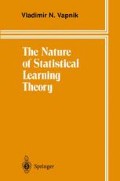Abstract
In the history of research of the learning problem one can extract four periods that can be characterized by four bright events:
-
(i)
Constructing the first learning machines,
-
(ii)
constructing the fundamentals of the theory,
-
(iii)
constructing neural networks,
-
(iv)
constructing the alternatives to neural networks.
Access this chapter
Tax calculation will be finalised at checkout
Purchases are for personal use only
Preview
Unable to display preview. Download preview PDF.
References
Note that discriminant analysis as proposed in the 1930s by Fisher actually did not consider the problem of inductive inference (the problem of estimating the discriminant rules using the examples). This happened later, after Rosenblatt’s work. In the 1930s discriminant analysis was considered a problem of constructing a decision rule separating two categories of vectors using given probability distribution functions for these categories of vectors.
V. Vapnik and A. Chervonenkis, Theory of Pattern Recognition (in Russian), Nauka, Moscow, 1974.
German translation: W. N. Wapnik, A. Ja. Tscherwonenkis, Theorie der Zeichenerkennung, Akademia-Verlag, Berlin, 1979.
V. N. Vapnik, Estimation of Dependencies Based on Empirical Data (in Russian), Nauka, Moscow, 1979. English translation: Vladimir Vapnik, Estimation of Dependencies Based on Empirical Data, Springer, New York, 1982.
Convergence in probability to the best possible result. An exact definition of consistency is given in Section 2.1.
The back-propagation method was actually found in 1963 for solving some control problems (Brison, Denham and Dreyfuss, 1963) and was rediscovered for Perceptrons.
Of course it is very interesting to know how humans can learn. However, this is not necessarily the best way for creating an artificial learning machine. It has been noted that the study of birds flying was not very useful for constructing the airplane.
L.G. Valiant, 1984, “A theory of learnability”, Commun. ACM 27(11), 1134–1142.
“If the computational requirement is removed from the definition then we are left with the notion of nonparametric inference in the sense of statistics, as discussed in particular by Vapnik.” (L. Valiant, 1991, “A view of computational learning theory”, In the book: “Computation and Cognition”, Society for Industrial and Applied Mathematics, Philadelphia, p. 36.)
Author information
Authors and Affiliations
Rights and permissions
Copyright information
© 1995 Springer Science+Business Media New York
About this chapter
Cite this chapter
Vapnik, V.N. (1995). Introduction: Four Periods in the Research of the Learning Problem. In: The Nature of Statistical Learning Theory. Springer, New York, NY. https://doi.org/10.1007/978-1-4757-2440-0_1
Download citation
DOI: https://doi.org/10.1007/978-1-4757-2440-0_1
Publisher Name: Springer, New York, NY
Print ISBN: 978-1-4757-2442-4
Online ISBN: 978-1-4757-2440-0
eBook Packages: Springer Book Archive

